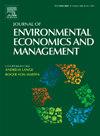洪水灾害对实体经济和金融中介的影响:利用 DSGE 模型进行模拟分析
IF 5.5
3区 经济学
Q1 BUSINESS
Journal of Environmental Economics and Management
Pub Date : 2024-09-16
DOI:10.1016/j.jeem.2024.103058
引用次数: 0
摘要
我们利用动态随机一般均衡(DSGE)模型评估了日本与洪水相关的有形风险。我们构建了一个包含洪水传导机制的模型,并利用政府在过去 40 年中收集的洪水对资本存量和公共基础设施造成的损害数据对模型进行了估算。分析结果有三个方面。首先,洪水直接导致私人资本存量减少约 0.1%,从而导致国内生产总值在第一阶段下降约 0.1%,然后逐渐恢复到洪水前的水平。其次,洪水通过多种渠道抑制国内生产总值。从供给方面看,资本存量投入和全要素生产率(TFP)的下降会降低国内生产总值。从需求方面看,企业和金融中介机构的资产负债表受损,导致金融中介活动中断,从而抑制国内生产总值。根据我们的估计,所有这些渠道在数量上都具有可比性。第三,与现有宏观经济研究中认为重要的标准结构性冲击相比,洪水冲击到目前为止对国内生产总值的定量影响较小。然而,根据绿化金融体系网络(NGFS)发布的利用我们模型中关键变量之间的关系以及气候变化情景的估算,这些冲击的影响在未来可能会变得更大。本文章由计算机程序翻译,如有差异,请以英文原文为准。
Transmission of flood damage to the real economy and financial intermediation: Simulation analysis using a DSGE model
We assess physical risk associated with floods in Japan, using a dynamic stochastic general equilibrium (DSGE) model. We construct a model that incorporates transmission mechanism of floods and estimate the model using the data of flood-induced damage to capital stock and public infrastructure collected by the government in the last 40 years. The result of the analysis is threefold. First, a flood that reduces the private capital stock by about 0.1% as a direct effect causes GDP to fall by about 0.1% in the first period, with a gradual recovery to pre-flood level. Second, floods dampen GDP through multiple channels. From the supply side, a decline in capital stock inputs and total factor productivity (TFP) reduce GDP. From the demand side, the balance sheets of firms and financial intermediaries are impaired, resulting in disruptions to financial intermediation and depressing GDP. Based on our estimates, all these channels are quantitatively comparable in magnitude. Third, the quantitative impacts of flood shocks on GDP up to now have been minor compared to the standard structural shocks that are considered important in existing macroeconomic studies. However, according to the estimates that use the relationship between the key variables in our model together with climate change scenarios published by the Network for Greening the Financial System (NGFS), the impacts of these shocks could become somewhat larger in the future.
求助全文
通过发布文献求助,成功后即可免费获取论文全文。
去求助
来源期刊
CiteScore
8.00
自引率
4.30%
发文量
91
期刊介绍:
The Journal of Environmental Economics and Management publishes theoretical and empirical papers devoted to specific natural resources and environmental issues. For consideration, papers should (1) contain a substantial element embodying the linkage between economic systems and environmental and natural resources systems or (2) be of substantial importance in understanding the management and/or social control of the economy in its relations with the natural environment. Although the general orientation of the journal is toward economics, interdisciplinary papers by researchers in other fields of interest to resource and environmental economists will be welcomed.

 求助内容:
求助内容: 应助结果提醒方式:
应助结果提醒方式:


